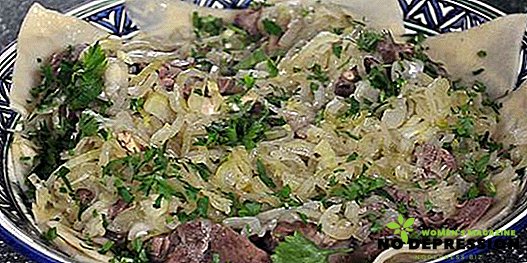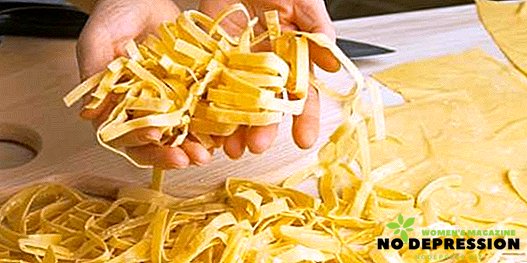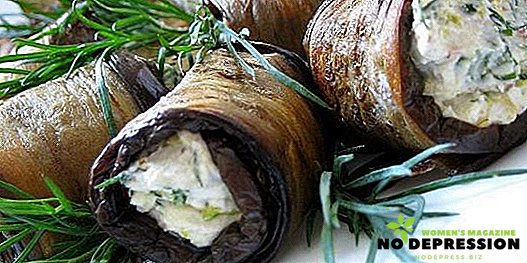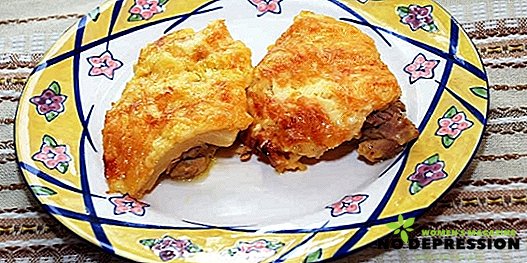Middle Eastern dishes are distinguished by a wide variety of all sorts of nutritious meat and fairly simple recipes, since the life style of most of these peoples was a nomadic way of life for caravanders who needed to prepare rich meals on the way, not requiring complicated manipulations in the process of creation.
One of these dishes is beshbarmak. In itself, the dish is a large meat-and-flour "sandwich" with onions, which are heavily crushed.

What is this dish, the subtleties of its preparation and serving
For all its simplicity, beshbarmak is a festive dish and no important event in the traditional culture of the Turkic peoples can do without it. In almost all Turkic languages, this name is understood and the dish itself is very widespread among the peoples of the Middle East.
Its main ingredient is meat, and there are variations where horse meat, lamb, goose, beef, and even sausage or giblets are used. Meat is cooked for a reason, and mixed with onions, special dough and, as is customary with the Kazakhs in the north, with potatoes.
A special place in the preparation is occupied by the dough: it is yeast-free, as is often the case in the Middle Eastern cuisine, and is made from the calculation of 200 ml of broth (you can water) for 600 g of flour, 2 eggs, half a teaspoon of salt.
The dough preparation technique is similar to the noodle making technique: the flour is mixed with the broth, slightly stirred with eggs, salt and kneaded, after which it is wrapped in plastic wrap and brewed for half an hour. Then small pieces of dough come off and roll out on a floured table up to 1.5-2 mm thick, after which they are cut into diamonds, after which they are left to lie so sprinkled with flour.
With regard to serving, there are several important observations: with the dish itself there are a number of related customs in the distribution of roles in the cooking process, the order of use and related customs, which depend on a particular people. Among the residents of eastern Kazakhstan, the custom was formed to serve beshbarmak with rice, and the broth from the meat - in a separate bowl.
To the west and the use of sturgeon is allowed. Noodles can be cut into long slices, short or crumbled with meat, as in Turkmenistan, into a practically uniform mass, filled with broth.
How to cook beshbarmak at home
So, in fact, a classic cooking recipe at home.
It is necessary:
- Meat - 1 kg;
- Onions - 2-3 pieces;
- Flour - 600 g;
- Salt - 0.5 tsp. on the dough, the rest - to taste;
- Eggs - 2 pieces;
- Spices - to taste;
- Vegetable oil, but better fat from the same meat.
It will take about 5 hours to prepare. Calorie content will be about 1000 kcal per serving.
Since a full-sized cauldron is not in every kitchen, it is enough to take a large-volume pan (4-5 l) and put the washed meat to cook. You can choose any: lamb, beef, horse meat (with this, for sure, more difficult). Almost any parts will do, but the presence of a bone is nevertheless necessary.
Meat is poured into cold water and over medium heat is brought to a boil, after which the fire is reduced to a minimum and boiled until 4 hours. One hour before the end of cooking, carrots and onions are added.
It is necessary that the meat lagged behind the bone very easily. While the meat is boiled, you can do the dough and make it according to the above recipe - it is universal for all versions of beshbarmak.
The finished meat comes from the water, all vegetables are removed from it, and the bones are also removed and the meat itself is divided into small fibers by hand or crushed with a knife. Next, fresh onion is cut into rings, and half is spread on the pan with fat, separated from the meat during cooking, and fried until soft.
The second half in a colander is dipped in boiling broth for a minute or two, and then dried and sprinkled with ground pepper. In a separate saucepan with the same broth, cook the noodles, already folded in sliced form, until cooked.
It is not necessary to digest it, after cooking pour it into a colander and mix with fried onions. It is important to prevent pasting noodles.
The finished dish is served like this: noodles are laid out on a flat dish, meat is on top and sprinkled with onions, which are kept in the broth. The broth is served in this case in a bowl with chopped greens.
Beefbarmak from beef: a step-by-step recipe in Uzbek
One of the cooking options was formed in Uzbekistan. As in the case of the classic recipe, meat is first cooked. Similarly, it is necessary to achieve a state when it is completely moving away from the bone.
It will take:
- Beef - 0.5 kg;
- Eggs - 2 pieces;
- Flour - 600 g;
- Onions - 2-3 pieces;
- Celery root - 200 g
- Salt - 0.5 tsp. on the dough, the rest - to taste;
- Spices - to taste;
- Vegetable oil and fat.
It will take 3 hours. Calorie - about 1000 kcal per serving.
Cooking:
- Meat cooking takes two hours; foam should be removed;
- Bay leaf and chopped celery root are added to the broth;
- When the meat is ready, you need to get it to let it cool;
- Broth drains from everything;
- The dough is kneaded in parallel or after all the manipulations of the meat;
- Noodles are cut into long slices;

- It is boiled in broth until cooked;
- Onions are fried in a pan with rings of butter or fat.
The dish is served on a plate in the same order: noodles, meat onions, onions and drizzled with fat, seasoned with spices and herbs.
Beshbarmak: Tartar's recipe
In the case of Tatar beshbarmak, more deviations from the classical recipe are allowed, namely, the use of potatoes, carrots, the combination of different types of meat in one dish. So, here is the recipe itself.
Products:
- Meat - 0.5 kg;
- Flour - 750 g;
- Eggs - 1 pc;
- Spices - to taste;
- Onions - 2-3 pieces;
- Potatoes;
- Carrot;
- Vegetable oil and fat.
It will take 3 hours. Calorie - 1000 kcal per serving.
The meat is cooked until fully cooked, at the time of boiling the sliced onion and carrot are put into the water, and in the meantime the dough is prepared. To do this, the egg is whipped with a glass of water and a spoon of oil in a bowl, salted and sprinkled with flour.
The dough should be steep and elastic. Covered with a towel, it costs half an hour. Further, it is rolled out on thin layers (2-3 mm) and cut into 5-8 cm squares.
The finished meat is removed from the broth and divided into pieces. Onions cut into rings and stand in a colander in boiling broth. After a few minutes of blanching, it is put on a plate, and the same broth is put in potatoes, cut into 3-4 pieces and cooked until ready.
It is spread on a dish, and cook the noodles all in the same broth. The noodles are laid out on top of the potatoes, then - onions, and on top - meat seasoned with herbs and spices.

Beshbarmak in Kyrgyz lamb with offal
The difference of this recipe is mainly in the use of offal in combination with meat. In general, everything is very similar, now more.
This recipe requires the following products:
- Lamb - 600 g;
- Stomach - 20 g;
- Liver, kidneys, heart - 200 g;
- Sheep lung - 200 g;
- Onion - 4 pcs;
- Ground black pepper to taste;
- Black pepper peas - to taste;
- Ground red pepper - 0.5 g;
- Salt - to taste;
- Flour - 300 g;
- Eggs - 1 pc;
- Ground black pepper - pinch;
- Salt on the dough - pinch.
It takes 3 hours to cook. Calorie - about 1000 kcal per serving.
Meat is cooked with offal. Noodles are prepared according to a similar scheme, boiled in broth, from which they extracted meat and giblets. Red pepper is added when cooking meat in broth. The noodles in the form of ribbons are laid out on a plate, finely chopped meat with offal is placed on top of it and mixed with onions.
In the Kyrgyz version, historically, each part of the ram is also important. During a meal or celebration, beshbarmak is served at the dastarkhan, and people gathered to distribute different parts of the meat, depending on their position and age.
At the same time, in Turkmenistan, the best parts always relied to the guests and those who wanted to honor most of all for the meal, while the owner was busy with the satiety of those who came.
Chicken beshbarmak recipe in a slow cooker
For cooking you will need:
- Chicken - 1 pc;
- Onions - 1-2 pcs;
- Beshbarmak noodles;
- Salt and pepper to taste;
- Potatoes - 6-8 pcs.
It takes about 3.5 hours to cook. Calorie - 200 kcal per serving.
The chicken should be washed and cut into small pieces immediately. Cook it should be about the same as in the case with the usual for this dish, however, in the slow cooker, this is achieved by a consistent choice of programs.
The meat is boiled for 3 hours in the "Quenching" mode, the water should be slightly higher than it. Depending on the power of the unit, the time interval can be reduced.
Two hours later, half-cut potatoes are added. Next onions are cut into rings and stewed in a pan with part of the broth. In a bowl with broth in the "Steaming" mode, the noodles are cooked until tender with stirring.
Ready noodles are laid out in a plate, potatoes and meat are on top, all this is sprinkled with onions and greens. The broth is poured over the whole dish, and it is poured into a bowl.
Beshbarmak in Issyk-Kulsky
This recipe is one of the local ones and quite interesting, especially if you like fish.
Would need:
- Fresh fish - 1 kg;
- Noodles - 400 g;
- Bulb onion - 1-2 pieces;
- Salt and pepper to taste;
- Bay leaf.
It will take 2 hours. Calorie content is about 100 kcal.
The fish is cleaned, then cooked until tender, after which it needs to be stoned and crumbled. Noodles are cooked, according to tradition, in the same broth. Next onion sauce is prepared with bay leaf, salt and pepper for about 10 minutes, all in the same broth. Served dish on noodles, poured sauce.
Useful tips
The first and most important advice is that you shouldn’t complicate the classic recipe, because simplicity is its main essence. Beshbarmak itself is fat and high in calories, so it is not suitable for a dietary diet. The chicken version can solve this question, but its taste will not be canonical at all.
The second tip is to use fresh vegetables and rinse the meat thoroughly. Broth should be transparent and nourishing. In the case of by-products, it is also important to ensure that the giblets are clean and rinse them well before cooking.
The fourth advice is to boil the meat for a very long time so that it is not tough and falls apart into pieces in the hands, otherwise the dish itself will not work. The name suggests using the dish with your hands (besh - five, barmak - fingers), so everything should be prepared as ready as possible to eat.
The Kazakh version of beshbarmak cooking is shown in the next video.













